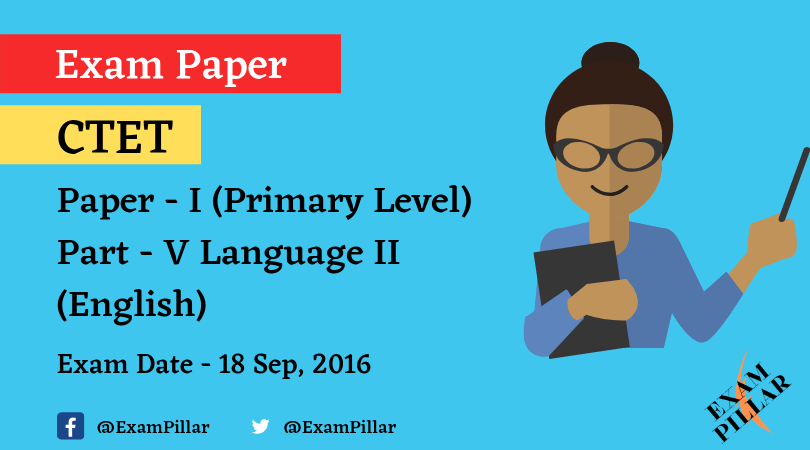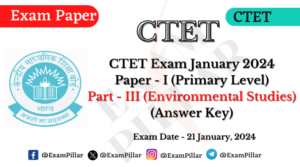CBSE conducted the CTET (Central Teacher Eligibility Test) Exam Paper held on 18th Sep 2016 Morning and Evening Shift. Here The CTET Solved Question Paper I (Class I to V) Solved Paper.
CTET (Central Teachers Eligibility Test) Paper First Session : Primary Level (Class 1 to Class 5).
Exam – CTET Paper I (Class I to V)
Part – V Language II (English)
Organized – CBSE
Number of Question – 30
Exam Date – 18th Sept 2016
Read Also….
- CTET 2016 Paper -I – Part – I – बाल विकास और शिक्षा-शास्त्र (Child Development and Pedagogy)
- CTET 2016 Paper -I – Part – II – गणित (Mathematics)
- CTET 2016 Paper -I – Part – III – पर्यावरण अध्ययन (Environmental Studies)
- CTET 2016 Paper -I – Part – IV – Language – I (English)
- CTET 2016 Paper -I – Part – IV – Language – I हिंदी (Hindi)
- CTET 2016 Paper -I -Part – V – Language – II हिंदी (Hindi)
CTET Exam September 2016 Paper – 1 (Junior Level)
Part – V Language II (English)
Directions : Answer the following questions (Q. Nos. 1 to 15) by selecting the correct/most appropriate options.
1. Language is not :
(1) social
(2) arbitrary
(3) symbolic
(4) instinctive
Show Answer/Hide
2. When language development is a deliberate and conscious effort, language is :
(1) brushed up
(2) learned
(3) acquired
(4) honed
Show Answer/Hide
3. What is a ‘task’ in task-based language learning?
(1) A piece of work for the parents to do their children’s homework
(2) A piece of activity for teachers to do in the classroom
(3) A piece of work which exposes learners to language
(4) A piece of work which enables learners to do an activity
Show Answer/Hide
4. Travelogue is a genre of :
(1) bibliography
(2) literature
(3) poetry
(4) criticism
Show Answer/Hide
5. The most important aspect of an effective language classroom is with an to provide learners opportunity to :
(1) interfere
(2) assess
(3) imitate
(4) interact
Show Answer/Hide
6. A teacher of Class V is practising ‘interactive listening’ in the class. She should focus on :
(1) listening to word stress and intonation
(2) listening to the pronunciation
(3) listening and responding
(4) listening and speakers attitude observing
Show Answer/Hide
7. A word with same spelling and same pronunciation as another, but with a different meaning is a/an :
(1) homophone
(2) antonym
(3) synonym
(4) homonym
Show Answer/Hide
8. A shorter form of a group of words, which usually occurs in an auxiliary verb, is :
(1) connector
(2) contraction
(3) conjunction
(4) connotation
Show Answer/Hide
9. Aditi, a visually challenged child in Class IV, does not have any text in braille. How can a teacher facilitate her in reading the English textbook?
(1) Instead of focussing on this single child, she may use her energy in teaching the remaining class.
(2) She may ask her parents to look after their child.
(3) She may ask the principal to arrange a special teacher for her.
(4) She may arrange and give the audio CD of the textbook to the child.
Show Answer/Hide
10. Poetry teaching is generally meant for :
(1) learning punctuation
(2) enjoyment and appreciation
(3) language learning
(4) learning grammar as a second
Show Answer/Hide
11. Reading English language means :
(1) reading for grammar
(2) meaning making
(3) decoding of letters and words
(4) reading aloud
Show Answer/Hide
12. When learners give feedback on each other’s language, work, learning strategies, performance, etc., it is called :
(1) group assessment
(2) self-assessment
(3) peer assessment
(4) formal assessment
Show Answer/Hide
13. A teacher after completing a chapter ask the students some questions to review their learning and check their understanding. The questions she is asking will be based on
(1) hyper order thinking skills
(2) higher order thinking skills
(3) middle order thinking skills
(4) lower order thinking skills
Show Answer/Hide
14. A good teaching-learning material (TIM) can best :
(1) help the teacher to transact material without any modification
(2) help the a language learners acquire
(3) facilitate the teaching-learning process
(4) be a source of entertainment
Show Answer/Hide
15. While providing feedback to the parents, a teacher should not ;
(1) share the incidents recorded in the anecdotes
(2) compare their child with other children
(3) compare the current performance of the child with her previous performance
(4) give qualitative feedback about the child
Show Answer/Hide




